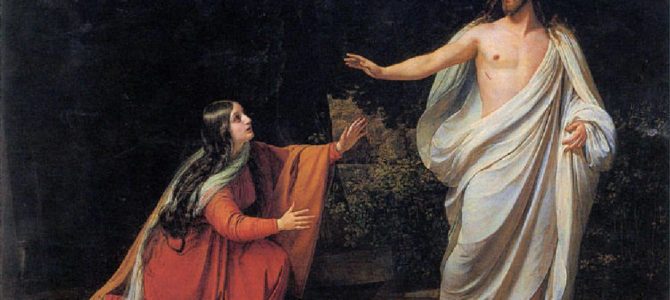
July 22 marks the first anniversary of Pope Francis’ feast celebration (elevated from its previous memorial) on the liturgical calendar for a woman from the Galilean village Magdala Nunayya (meaning “tower of salted fish”) usually called Maria. Mary Magdalene is introduced in Luke 8:2-3 as a follower who accompanied and financially supported the disciples after Jesus had cast out seven demons from her, an identification repeated in Mark 16:9.
Her most extensive gospel references are reserved for the end of Jesus’ ministry, observing the crucifixion from afar in Mark 15:40 and Matthew 27:56, and near the cross in John 19:25. Mark 15:47 and Mathew 27:61 place Magdalene in attendance at Christ’s burial. The gospels describe Magdalene’s witness of the empty tomb in Mark 16:1, Matthew 28:1, Luke 24:10, and John 20:1.
Identified solely by her place of origin notable for its commerce, she was likely a woman of independent affluence to be able to help sustain an itinerant band of healers. Ancient historians Josephus in “War” and Strabo in “Geography” call the village Taricheae, located along the lake shore three miles northwest of Tiberius. Excavation at al-Majdal reveals a Roman-era synagogue in the upper left region of the aerial photograph below.

Mary Magdalene Has Been Folded Into Many Women
Unfortunately for her legacy as first witness to the resurrection in John 20:11-18, Saint Mary Magdalene has been conflated with the “sinner” in Luke 7:36-39 who anointed Jesus’ feet with perfume and washed them with her tears in the house of Simon the Pharisee, presumably near Mount Tabor (in Galilee). Magdalene has also been confused with Mary of Bethany, the sister of Lazarus and Martha in Luke 10:38-42 and John 11:1.
Mark 14:3 and Matthew 28:6-7 describe another unnamed woman anointing Jesus’ head in the house of Simon the leper in Bethany (Judea), while John 12:1-3 places the incident in the house of Lazarus (in Bethany) and identifies the anointer as his sister Mary. Thus, three ostensibly separate anointments have consolidated to present one grateful female adult, namely Magdalene, as the avatar for contrition.
In ad 591, Pope Gregory I equated Mary Magdalene with prostitution in Homily 33: “She whom Luke calls the sinful woman, whom John calls Mary, we believe to be Mary from whom seven devils were ejected according to Mark. And what did these seven devils signify, if not all the vices? … It is clear, brothers, that the woman previously used the unguent to perfume her flesh in forbidden acts.” No benefit of the doubt here.
In the thirteenth and fourteenth centuries, Magdalene was further assumed to be the bride at the wedding at Cana in John 2:1-2, along with the apostle John as the groom who after Jesus’ wine-converting miracle eschews marriage to become a disciple. A few years ago, the “Wife of Jesus” papyrus fragment, purportedly from the fourth century, identified Mary Magdalene as the lover or wife of Jesus, while Dan Brown’s novel “The Da Vinci Code” introduced this interpretation to a wide audience. Subsequent analyses concluded that the text was a forgery.
To fill in absent information or to reduce a cast of characters in stories, people sometimes combine characteristics into a composite personality. Early Christians promoted sexual asceticism, providing an escape for young women from the travails of marriage and the risks of childbirth as suggested by the apostle Paul in 1 Corinthians 7:28. The second century’s “Acts of Paul and Thecla” particularly extolled the ideal of virginity—adopted by the Encratite sect of that period. The honor of celibacy over marriage became doctrine through the ad 393 synods at Rome and Milan, condemning such denial in the Jovinian heresy.
Thus, sinful women in the New Testament must have been prostitutes who traded sexual access for material nourishment—doubly wicked for seeking worldly goods in exchange for providing erotic pleasures instead of enduring poverty and embracing chastity. Penitent women who renounced such deeds after formerly indulging in such vices could seek salvation, but nevertheless remain inferior to their purer sisters. In Magdalene’s case, the affiliation of sin and redemption became too convenient a metaphor to not be exploited as a model for emulation, especially in conjunction with and contrast to Jesus’ mother, the ever Virgin Mary.
The Penitent Woman in Art
This emphasis on penitence is further reflected in art. The wood sculpture “Marija Magdalena” by Danatello from 1455 reveals a haggard and gaunt Magdalene garbed in ragged attire standing plaintively, anguishing over her grievous sins. Annibale Carracci produced the “The Penitent Magdalen in a Landscape” in 1598 with a contemplative and well-nourished half-robed Magdalene sitting in a glade and gazing skyward with curled red hair draping over her shoulder.


Similar images of full-fleshed maidens appear more common than the alterative in subsequent centuries. For example, Batoni Pompeo Girolamo painted “Maria Maddalena Penitente” in 1760, depicting a casually reclined Magdalene reading an anachronistic codex (bound book) inside an apparent grotto, her blonde tresses dangling over both arms. Susan Haskins in “Mary Magdalen: Myth and Metaphor” describes sundry Renaissance portrayals.

While these and other depictions demonstrate their own distinctiveness, they nonetheless all engender a woman with a conscious desire for redemption, however expressed. Their images suggest an approachability and humanity consistent with her audacity in John 20:18 to tell the disciples of her risen savior.
Even in this century, these conjectures of shame and remorse resurface, albeit sometimes less overtly. Preaching about St. Mary Magdalene, Pope Francis highlighted Christ’s mercy toward a woman who was “exploited and despised by those who believed they were righteous,” but she was loved and forgiven by him. Pope Francis mentions her specifically in the prayer he composed for the Year of Mercy: “Your loving gaze freed … the adulteress and Magdalene from seeking happiness only in created things….”
The Politics of Female Sexuality
The transformation of Magdalene’s epitaph from resurrection witness to penitent whore echoed the common denigration of women in past millennia. Whereas Saint Paul emphasizes sexual reciprocity in 1 Corinthians 7:28 and 11:11, and praises several women in Romans 16:1-16 for their services in the church, the post-Pauline epistle in 1 Timothy 2:12 demands their silence and relegates them to the background.
This misogynist attitude is not confined to religious advocacy, but was encouraged by ancient Greek philosophers including Aristotle (fourth century BC), who justified the disposition of inferiority based on a woman’s biology as a “mutilated male” in “Generation of Animals” — thereby pronouncing in “Politics” that women lack sovereignty. (In a plug for STEM, one doesn’t encounter such prejudice in Euclid.)
Patrician-era apologists continued these libels, including Tertullian, who condemned the female sex as the “devil’s gateway” in “De Cultu Feminarum” and Saint Augustine who argued in “De Trinitate” that a woman alone isn’t the image of God (imago Dei) unlike a man. Even thirteenth century Saint Thomas Aquinas maintained in “Summa Theologica” that “woman is defective and misbegotten.” Because Jesus’ mother was assigned the epitome of celibacy, someone else would be appointed the default stand-in for those who declined continuous religious contemplation in perpetual sexual abstinence. Coupled with Pope Gregory’s association with other women who had been subjects of gossip, that person became Mary Magdalene.
Legends of Mary Magdalene Outside Orthodox Christianity
Legends surrounding Magdalene also extend outside orthodox Christianity. The fifth century Codex Berolinensis, discovered in 1896, includes a Coptic portion of “The Gospel of Mary.”. Subsequently two small Greek fragments were also found of this Gnostic text. This document describes the post-resurrection Magdalene as the disciple having been closest of Jesus and thus privy to select teachings by her visions. Andrew and Peter challenge Magdalene’s assertions only to be scolded by Levi for their disrespect.
In 1945, a collection of Coptic codices dating from the second to fourth centuries were discovered at Nag Hammadi in Egypt. These primarily Gnostic literary works edited by Marvin Meyer in “The Nag Hammadi Scriptures” include a third-century document modernly titled “The Gospel of Philip” that mentions Magdalene by the passage: “There were three who walked with the Lord at all times, Mary his mother and her sister and Magdalene, whom they called his consort.”
Another reference with lacunae recites the vague but titillating lines: “And the consort of […] Mary Magdalene. [… loved] her more than [all] the disciples and kissed her [mouth]…” These meager references instigate much of the argument surrounding a marriage between Jesus and Magdalene. Among the 49 documents in the cache of Coptic manuscripts, only two others mention “Mary” (presumably Magdalene): “The Dialogue of the Savior” where she asks a question, and “The First Revelation of James” in passing. Thus, even these post-apostolic references add little information and that meager supplement being ambiguous.
Humans crave narrative with which to derive meaning at the expense of accuracy. History is rather more nuanced and less definitive in her pronouncements. The New Testament provides only glimpses of Magdalene and only the subtlest hints about her status in society. Especially on her liturgical promotion, she deserves the attention received for her role in Jesus’ ministry, but absent finger-wagging admonitions from scolds traduced over the centuries. Her company during the disciples’ sojourn and at the cross is reason enough for this feast day.









